The Global Trade Item Number (GTIN) is used for identification of a company and product to support supply chain efficiencies in various business processes, including ordering communication about product movement and traceability. The GTIN is is used to identify an item, package or case for fresh produce. It is encoded in a barcode.
There are three different Global Trade Item Numbers (GTINs) used in the fresh produce industry. They are 12, 13 or 14-digit numbers called GTIN-12, GTIN-13 and GTIN-14 respectively. GTIN-12s and GTIN-13s are the product identification numbers used to identify products passing at point-of-sale. GTIN-14s are the non-retail product identification numbers primarily used to identify groupings of identical retail items (such as cases). The GTIN is the most widely used standard in the world, being used by more than a million companies in over 100 countries.

GTIN Components
A GTIN consists of a GS1 Company Prefix, an Item Reference Number and a Check Digit.
What is a GS1 Company Prefix?
A GS1 Company Prefix must be licensed from GS1. The company prefix uniquely identifies your company as the brand owner of the item. It expires annually, so a company needs to maintain its subscription for the company prefix in order to use it. The prefix is not a stand-alone number; it appears at the beginning of the identification number or GTIN beneath the barcode.
Your GS1 Company Prefix:
- is specific to your company
- provides the ability to create new GTINs as needed
- must be renewed annually to keep existing barcodes registered
When licensing a company prefix from GS1 in the United States or Canada, in addition to the GS1 Company Prefix, you will receive a UPC Company Prefix which is only used to create GTIN-12s for UPCs.
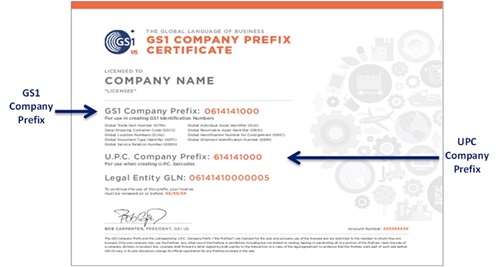
The GS1 UPC Company Prefix varies from 6 to 10 digits in length, where the GS1 Company Prefix varies from 7-11 digits in length. The size of your company prefix is determined based on the capacity or business needs for your organization. In the table below, it is illustrated how the differing number of GTINs needed affects the size of your prefix. A company with needs of uniquely identifying a smaller number of different products will be assigned a longer company prefix.
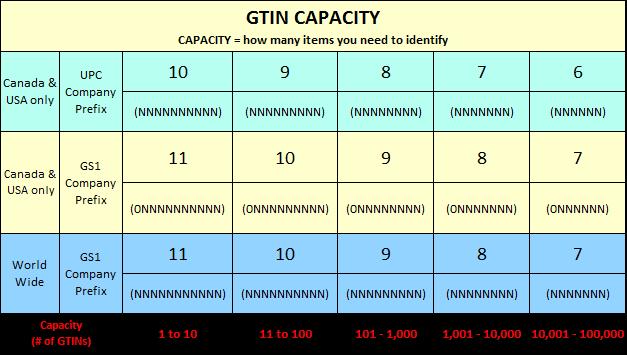
What is an Item Reference Number?
The next component of a GTIN is the Item Reference Number, which is assigned by the brand owner and identifies the item. It is not recommended to build any logic into the Item Reference Number assignment, but instead start from the lowest number and continue in sequence for all of your items in your product catalog.
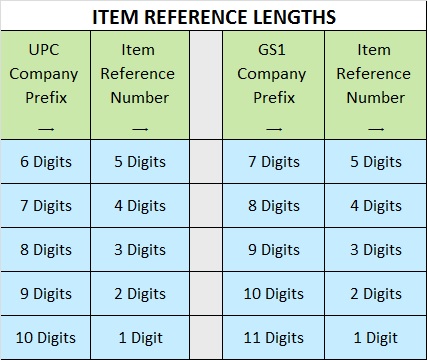
What is a Check Digit?
To complete the GTIN, a check digit is added, which is always the last digit of a GTIN. It is calculated by all other preceding numbers and guarantees that your GITN has been accurately created. GS1 has a check digit calculator that assists in check digit assignment. The numbers preceding the check digit are entered into the ID Number field in the calculator display below, and the check digit is identified.
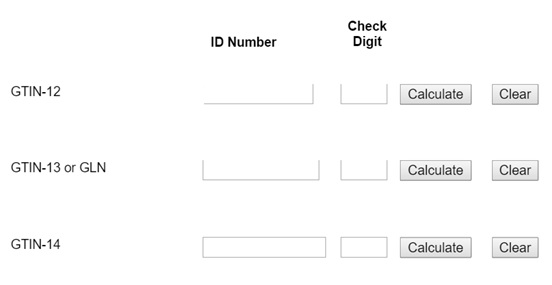
In the United States and Canada, a UPC Company Prefix is used to create GTINs for the UPC barcode. The UPC Company Prefix varies in length from 6-10 digits. The GS1 Company Prefix in the United States and Canada is simply the UPC Company Prefix with a preceding zero.
Example:
UPC Company Prefix = 614141
GS1 Company Prefix = 0614141
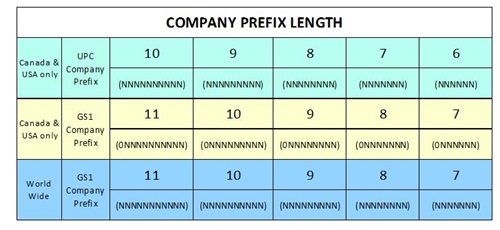
Building a GTIN
In North America, one of the most recognizable GS1 standards is the GTIN-12, which is the data structure or identification number used for the UPC barcode. The GTIN-12 is 12 digits long and uses the GS1 UPC Company Prefix.
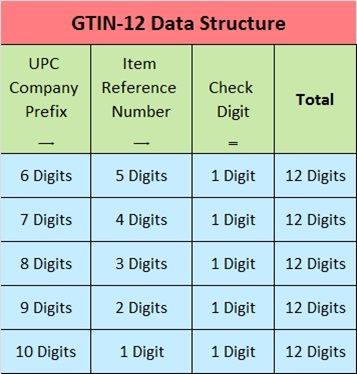
Building the GTIN-12
- Begin with your GS1 UPC Company Prefix
- Assign your Item Reference Number
- Calculate your Check Digit
Elsewhere in the world, the GTIN-13 is used for packaged produce. The GTIN-13 is 13 digits long and uses the GS1 Company Prefix.
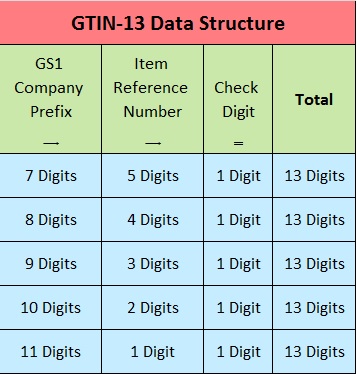
Building the GTIN-13
- Begin with your GS1 Company Prefix
- Assign your Item Reference Number
- Calculate your Check Digit
For case identification, a GTIN-14 is used and is typically imbedded in a GS1-128 barcode. The GTIN-14 is 14 digits in length and uses the GS1 Company Prefix. For the GTIN-14, the first digit is the Indicator Digit. It is only a component of the GTIN and relates to different packaging levels for fixed weight items. The Indicator Digit can be assigned a number from 1 to 8. The Indicator Digit is followed by the GS1 Company Prefix.
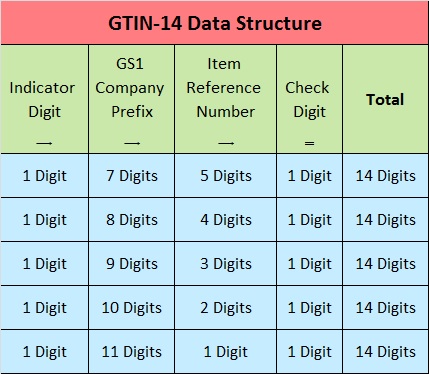
Building the GTIN-14
- Assign an Indicator Digit between numbers 1 - 8
- Follow with your GS1 Company Prefix
- Assign your Item Reference Number
- Calculate your Check Digit
Once the GTIN is built, all you need to do is to apply it to the product in a machine readable format. At this point, you are identifying what barcode symbology will be used.
GTIN Assignment
The relationship between different packaging and shipping levels is trade item hierarchy. It focuses on assigning the right GTIN to each level of packaging.
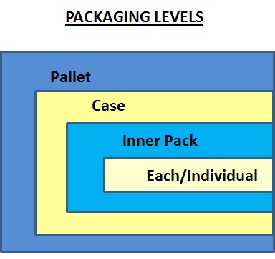
To assist with GTIN assignment at different packaging levels, an indicator digit is used. Numbers 1 to 8 are used for indicator digits. A leading zero distinguishes the lowest level of packaging.
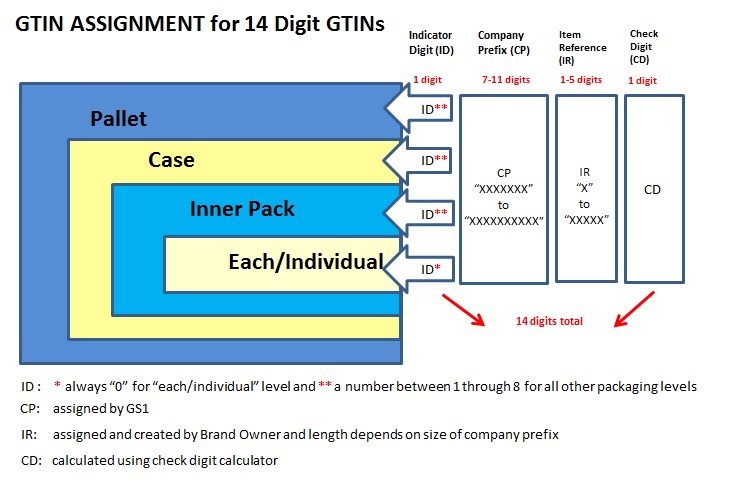
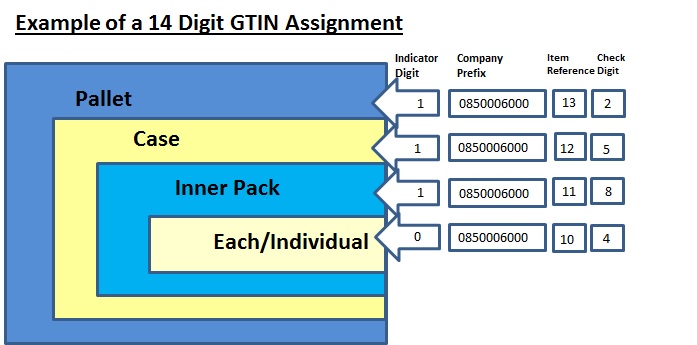
When GTINs are encoded in a barcode that must encode a fixed length data string of 14 digits, the GTINs less than 14 digits must be prefixed by leading zeros that simply act as filler characters.
There are rules governing when a GTIN must be changed. One example is when a product is reconfigured or repacked, the new product must be assigned a unique product identifier. The linkage must be maintained between the new product and its original inputs. For a complete list of GTIN assignment rules, please see the Fruit and Vegetable GTIN Assignment & Implementation Guide.


